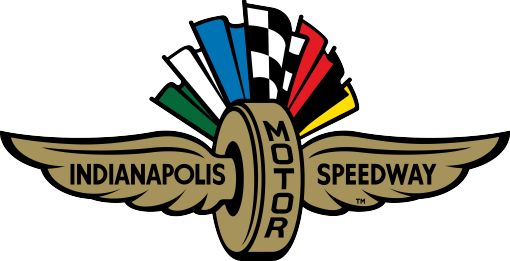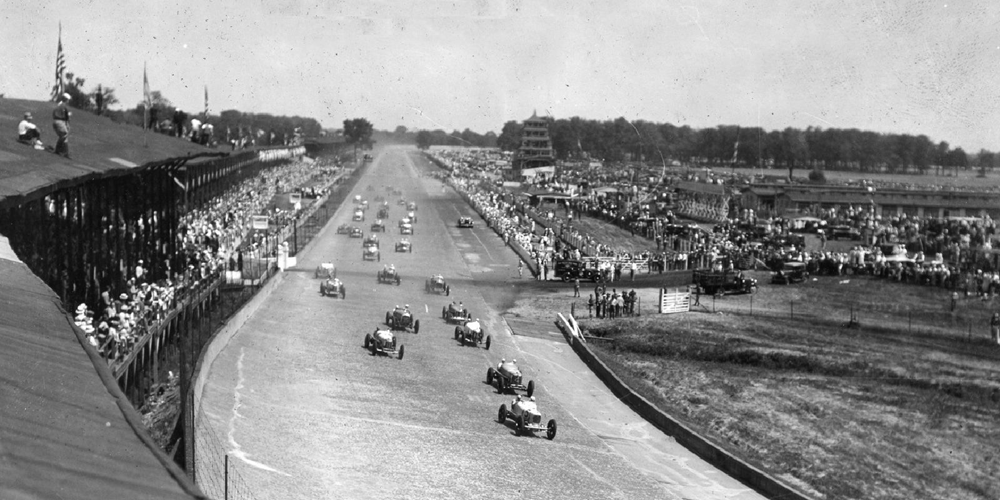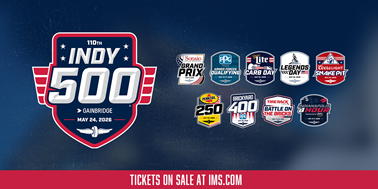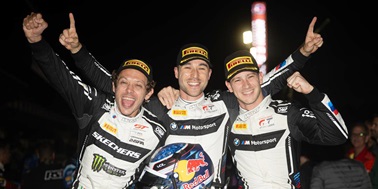1930
After more than a decade of domination by purpose-built racing cars, a considerably revised set of specifications was now in effect in an attempt to encourage the return of America’s automobile manufacturers.
Engine sizes—limited between 1926 and 1929 to only 91 ½ cubic inches—were now opened all the way up to 366. Supercharging was no longer permissible (except on two-cycle engines) and the riding mechanics, optional since 1923, were mandatory once again. Legend has it that these new “specs” were forced in by the collapse of the stock market, whereas, in fact, they had been announced in January 1929, a full 10 months before the Wall Street “crash.”
Although a number of production-engined cars did take part, none was factory-entered and Billy Arnold’s winning mount was a front-drive racing car, powered by an unsupercharged 151-cubic-inch Miller. The 24-year-old Arnold started from the pole and led the entire distance with exception of the first two laps, winning by more than seven minutes over second place. His prize money topped an amazing $50,000, which, largely due to the Depression of the mid-1930s, was to stand as a record for almost 20 years.
1931
The amazing Billy Arnold, who led 198 of the 200 laps on his way to winning in 1930, also led from laps seven to 161 of the 1931 event, until an accident took him out. With Arnold eliminated after having led 353 of the last 361 laps, the torch was passed to Louis Schneider.
Schneider was a former member of the Indianapolis Police Department motorcycle squad, whose penchant for dirt track racing in his spare time had caused him more than a few problems.
Finishing 13th in the 1931 race, which was delayed for a couple of hours by early morning rain, was a diesel-powered vehicle entered by the Cummins Engine Company of nearby Columbus, Indiana. Weighing almost 3,400 pounds, the combination of a diesel truck engine mounted in a special Duesenberg chassis completed the 500 miles about 37 minutes after Schneider had won the race, and it did so without making a single pit stop.
1932
Fred Frame won for driver-turned-owner Harry Hartz, but it was Frame’s teammate, Billy Arnold, who had most of the fans talking. Arnold, who led 198 of the 200 laps on his way to winning in 1930 and then led from lap seven until 162 in 1931, was the dominant driver again.
This time he took over on lap two and was never headed until lap 60, when he crashed while trying to avoid a spinning car. It extended his record over a three-year period to 411 laps led out of 421 completed, for an average of 97.62 percent.
Taking advantage of a revised set of rules designed to encourage a return of the major automobile companies, Studebaker of South Bend, Ind. commissioned a team of five racing cars to be powered by its eight-cylinder President passenger car engine. All five qualified, Cliff Bergere’s finishing third.
1933
In spite of the vice-like grip of the Great Depression on the country, the “500” went on regardless, with a surprisingly large and high-spirited number of people taking advantage of a reduction in the race-day general admission charge.
Not so happy were the participants, who were asked to accept a considerable reduction in prize money. Whereas Billy Arnold had earned a record $50,300 for winning in 1930, the total take by 1933 victor Louis Meyer, including lap prizes and accessory money, was only $18,000. Better days were ahead.
1934
Fuel economy was the subject on the mind of every participant going into the “500,” as each car was restricted to only 45 gallons of fuel for the entire distance. Bill Cummings, who personally never felt his nickname of “Wild Bill” was justified, suggested he should be renamed “Conservative William” after driving a very disciplined race to win by the closest margin up to that time, only 27 seconds over Mauri Rose.
A number of cars fell by the wayside, no doubt due to a short-lived rule which required that cars use the same gear ratios they had for qualifying. In the early stages of the race, two cars completely vaulted over the outer retaining wall in separate accidents, a growing problem at that time which soon would be addressed and remedied.
1935
Although frequently described as being “Irish–Italian,” there was nothing Irish about 1935 “500” winner Kelly Petillo. The son of an Italian immigrant, his name was actually Cavino Michelli Petillo.
As a child, he went by his middle name, the nickname “Kelly” reputedly coming about when a confused schoolteacher thought he was telling her, “Me Kelly.” Another myth, which persists to this day, is that his 1935 winning car was held together with baling wire. (He certainly borrowed a lot of parts to complete his Curly Wetteroth-built car for the race, and a rod through the crankcase during qualifying did require quite a bit of patching up, but there was no baling wire involved.)
Wilbur Shaw was runner-up for the second time in three races and Rex Mays, at 22, became the youngest ever pole-sitter, a record which has never been broken.
1936
This was a year of several notable “firsts.” Taking the checkered flag at a record average speed of 109.069 mph, Louis Meyer became the first driver to win the “500” for a third time.
He was also the first to be presented with the brand-new Borg–Warner Trophy, and he unknowingly started another tradition in Victory Lane by choosing to drink what appeared to be milk. It was, in fact, buttermilk, which had been his drink of choice since boyhood, his mother having told him it would refresh him on a hot day.
An executive with the milk industry saw the photos of Louis with the milk bottle in the following morning’s newspaper and vowed to make sure it happened again the following year. Milk would be offered to every winner through 1946 (there would be no races during World War II) and then, after a nine-year hiatus, to every winner since 1956.
1937
In the closest finish by far up to that point, Wilbur Shaw was able to nurse an ailing car home to complete the 500 miles with just 2.16 seconds to spare over fast-closing Ralph Hepburn.
Shaw, who not only owned the winning car but had designed and helped build it himself the year before (along with Myron Stevens), had a healthy lead when he began to notice the oil pressure dropping in the turns. While riding mechanic Jigger Johnson kept him apprised of Hepburn's rapid gaining, Shaw was able to save the engine by coasting through the turns and throttling only on the straights.
During qualifications, Jimmy Snyder obliterated the official one-lap track record with a 366-cubic-inch supercharged Sparks "six," raising it from 125.139 mph to an amazing 130.492 mph.
Lee Oldfield's V-16 Marmon–powered car, which practiced briefly and never made a qualifying attempt, forecast the future by being the first ever to be entered with the engine mounted behind the driver.
1938
Floyd Roberts, a 38-year-old South Dakota–born driver from Van Nuys, California, won the 1938 “500” at an average speed of 117.200 mph, a record which would last for 10 years.
In becoming only the third driver to win from the pole, Roberts also posted the first of five wins for driver-turned-owner Lou Moore. Roberts led 92 laps in the process, which was also the number led by Chicago’s Jimmy Snyder, who fell out with a supercharger failure at 154 laps.
The specifications for European Grand Prix racing were adopted for this year, calling for a 183-cubic-inch limitation on engines utilizing a supercharger and 274 cid for those which did not. This would remain basically unchanged at Indianapolis until 1957, when a slight reduction in piston displacement was made.
Defending winner Wilbur Shaw might have given Roberts a closer race had he not been delayed when a discarded glass drink bottle accidentally fell to the ground and shattered between his tires just as he was completing a pit stop. As it was, Shaw was able to claim second when Chet Miller was forced in for fuel only two laps from the end.
1939
Driving a recently imported Maserati, Wilbur Shaw won his second “500” in three years, but the victory lane celebration turned somber amid news that defending winner Floyd Roberts had lost his life in a three-car accident just past the halfway mark.
It appeared near the end that Louis Meyer, the “500’s” only triple winner at the time, might score for a fourth time. He had traded the lead throughout much of the event with Shaw and pole-sitter Jimmy Snyder, but had been passed by Shaw with 18 laps to go. He spun out in the effort to keep up and was forced to pit with a shredded tire.
He took up the chase, a lap down but still in second, only to spin again just two and a half laps from the finish. This time he slid out of turn two, within yards of where Roberts had perished a couple of hours earlier, and to everyone’s horror, Louis was thrown from the cockpit as the car broke through the inner wooden barrier. In spite of landing on the track on his hands and knees, he was able to get up and walk to the infield grass, deciding as he went that he had just become an ex–race driver.




